
Understand recursive functions
This post is free for all to read thanks to the investment Mindsers Courses members have made in our independent publication. If this work is meaningful to you, I invite you to join our courses today.
Recursive functions are one of my favorite development techniques. It's not a complicated thing. On the contrary, they are only functions used differently.
When we learn recursion, and more broadly, iteration in programming, we always stop at the classic iteration structures, loops. But they do not have a monopoly on iteration! In this article, I'll quickly tell you about another recursion structure.
Recursion and loops
When we talk about recursion or iteration, we are usually talking about repeating things. In computing, it is the ability to repeat a defined quantity of instructions.
As we said, the classic way is to use loops for this. Programming languages generally offer several types of loops:
whileloopsdo...whileloopsforloops
But, there are still others. In JavaScript, for example, we can add these to the list:
for...inloopsfor...ofloops
Generally, the loops added by the languages, in addition to the first three, are ultimately only specific variations of the first three loops.
I'm not going to explain loops to you here. They could be the subject of an article on their own. What must be remembered here is that loops are iterative structures offered by a language to allow a set of instructions to be repeated.
const list = ['one', 'two', 'three']
for(const element of list) {
// everything between the two braces
// will be repeated as many times as
// there are elements in list
}Example of loop in JavaScript
Recursion and functions
Unlike loops, functions are not iterative structures as such. They make it possible to separate a sequence of instructions from the rest of the code in order to be able to execute them again later, on demand.
This last sentence looks a bit like an iterative structure, but here are the main differences that can be noted:
- A defined function may be called only once, or even never.
- If there is repetition (execution several times), it will be neither immediate nor linear unlike a loop.
A function is therefore not an iterative structure provided by the language. What will make a function recursive, and therefore allow iteration, is the use that the developer will make of it.
Let's see how to make a function recursive.
function addOne(base, times = 1) {
let result = base
for (let i = 0; i < times; i++) {
result += 1
}
return result
}
addOne(5, 3) // === 8Function that uses iteration through a loop
This function is not recursive. It adds 1 to a number given as a parameter as many times as specified by the times variable.
How to do now, to have the same result without the loops?
function addOne(base, times = 1) {
if (times <= 0) return base
const result = base + 1
return addOne(result, times - 1) // everything happens here
}
addOne(5, 3) // === 8Function that uses iteration through recursion
The recursive function does not change signature. It always takes the base and times variables as parameters. It always returns a number.
What changes here: the function calls itself. That's all.
Let's go through the steps again with the parameters base=5 and times=3 to understand:
- Is
timesless than or equal to0? No, it is equal to3, we continue. resultis equal tobaseplus1, i.e.5 + 1, i.e.6.- We pass the
resultandtimes - 1to theaddOnefunction and we will directly return its return value when done. - Is
timesless than or equal to0? No, it is equal to2, we continue. resultis equal tobaseplus1, i.e.6 + 1, i.e.7.- We pass the
resultandtimes - 1to theaddOnefunction and we will directly return its return value when done. - Is
timesless than or equal to0? No, it is equal to1, we continue. resultis equal tobaseplus1, i.e.7 + 1, i.e.8.- We pass the
resultandtimes - 1to theaddOnefunction and we will directly return its return value when done. - Is
timesless than or equal to0? Yes, we returnbase, which is equal to8.
By doing it step by step, we better understand how a recursive function can completely replace an iteration structure like the loop.
The secret to mastering recursive functions is practice. You can get some exercises that I have prepared for you to progress on the topic in the shop : look for the Training Sheet: Recursive Functions.
Join 250+ developers and get notified every month about new content on the blog.
No spam ever. Unsubscribe in a single click at any time.
If you have any questions or advices, please create a comment below! I'll be really glad to read you. Also if you like this post, don't forget to share it with your friends. It helps a lot!